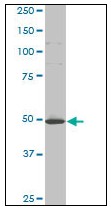Huntingtin (HTT) Mouse Monoclonal Antibody [Clone ID: 3F1]
Other products for "HTT"
Specifications
| Product Data | |
| Clone Name | 3F1 |
| Applications | ELISA, IHC, WB |
| Recommended Dilution | ELISA. Immunohistochemistry on Paraffin Sections: 5 µg/ml. Western Blot. |
| Reactivities | Human |
| Host | Mouse |
| Clonality | Monoclonal |
| Immunogen | HTT antibody was raised against hD (amino acids 81-191) partial recombinant protein with GST tag. Molecular weight of the GST tag alone is 26 kDa. |
| Specificity | This antibody reacts to HTT / Huntingtin. |
| Formulation | PBS, pH 7.2 State: Purified State: Liquid purified Ig fraction |
| Concentration | lot specific |
| Purification | Protein A chromatography |
| Storage | Store the antibody undiluted at 2-8°C for one month or (in aliquots) at -20°C for longer. Avoid repeated freezing and thawing. |
| Stability | Shelf life: one year from despatch. |
| Gene Name | Homo sapiens huntingtin (HTT) |
| Database Link | |
| Background | Huntingtin is a disease gene linked to Huntington's disease, a neurodegenerative disorder characterized by loss of striatal neurons. This is thought to be caused by an expanded, unstable trinucleotide repeat in the huntingtin gene, which translates as a polyglutamine repeat in the protein product. A fairly broad range in the number of trinucleotide repeats has been identified in normal controls, and repeat numbers in excess of 40 have been described as pathological. The huntingtin locus is large, spanning 180 kb and consisting of 67 exons. The huntingtin gene is widely expressed and is required for normal development. It is expressed as 2 alternatively polyadenylated forms displaying different relative abundance in various fetal and adult tissues. The larger transcript is approximately 13.7 kb and is expressed predominantly in adult and fetal brain whereas the smaller transcript of approximately 10.3 kb is more widely expressed. The genetic defect leading to Huntington's disease may not necessarily eliminate transcription, but may confer a new property on the mRNA or alter the function of the protein. One candidate is the huntingtin-associated protein-1, highly expressed in brain, which has increased affinity for huntingtin protein with expanded polyglutamine repeats. This gene contains an upstream open reading frame in the 5' UTR that inhibits expression of the huntingtin gene product through translational repression. |
| Synonyms | Huntington Disease Protein, HD, IT15, HTT |
| Reference Data | |
| Protein Families | Druggable Genome |
| Protein Pathways | Huntington's disease |
Documents
| Product Manuals |
| FAQs |
{0} Product Review(s)
0 Product Review(s)
Submit review
Be the first one to submit a review
Product Citations
*Delivery time may vary from web posted schedule. Occasional delays may occur due to unforeseen
complexities in the preparation of your product. International customers may expect an additional 1-2 weeks
in shipping.






























































































































































































































































 Germany
Germany
 Japan
Japan
 United Kingdom
United Kingdom
 China
China





